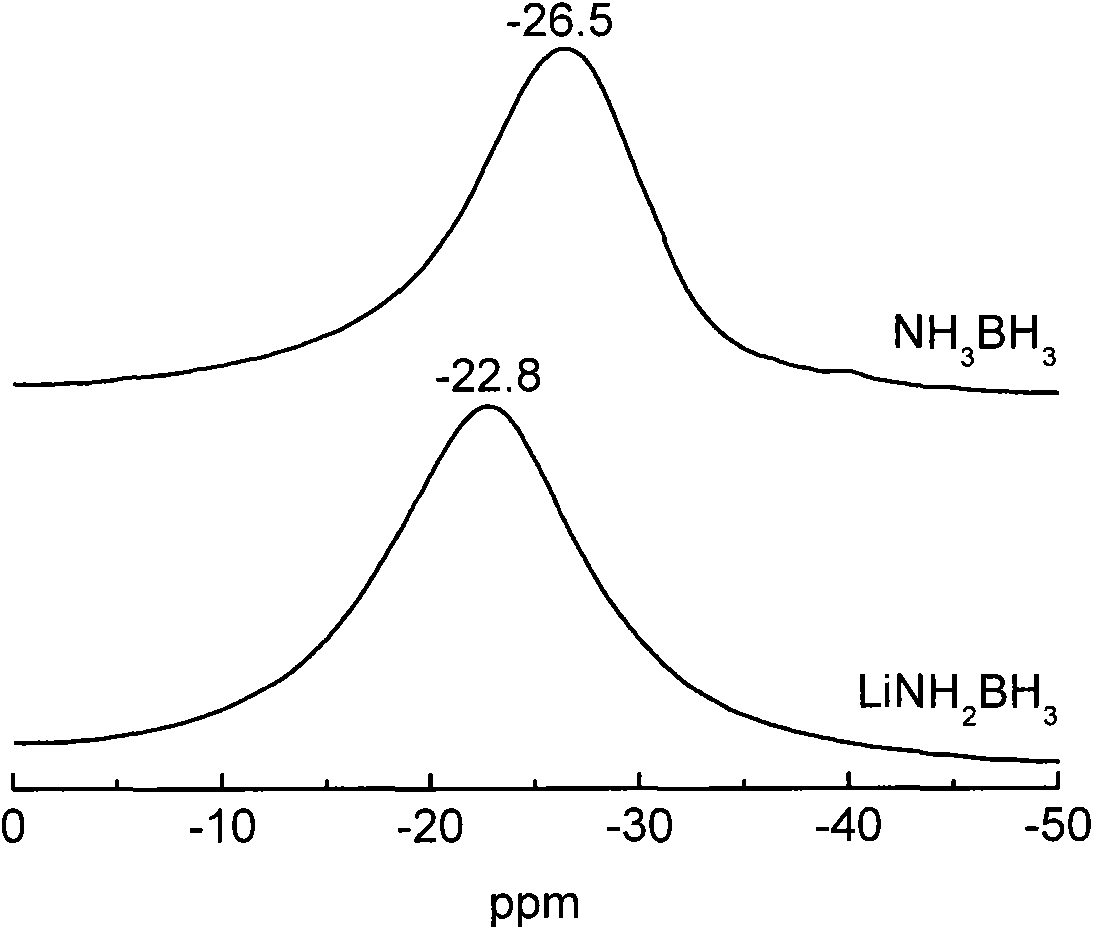Metal ammonia borane compound hydrogen storage material and preparation method thereof
A technology of metal ammonia borane and hydrogen storage materials, which is applied in the field of new metal ammonia borane compound hydrogen storage materials and its preparation, and can solve the problems of inability to meet the needs of vehicle-mounted hydrogen storage applications, limited ammonia borane solubility, and low hydrogen storage density. problem, to achieve the effect of low hydrogen release temperature, small heat release, and high hydrogen storage capacity
- Summary
- Abstract
- Description
- Claims
- Application Information
AI Technical Summary
Problems solved by technology
Method used
Image
Examples
Embodiment 1
[0025] Take NH 3 BH 3 + LiH as the starting material, LiNH was prepared by ball milling method 2 BH 3 Hydrogen storage material.
[0026] The raw material used is: NH 3 BH 3 , LiH (purity 95%, ~200 mesh). In an argon atmosphere glove box, a 1:1 molar ratio of NH 3 BH 3 / LiH mixture and stainless steel balls were put into a stainless steel ball mill jar, sealed with a cover and placed on a Fritsch 7 planetary ball mill for grinding for 2 hours. The ball milling atmosphere is high-purity argon (purity 99.9999%), and the initial pressure is 1 atmosphere. The ball to material mass ratio is 40:1.
[0027] Solid-state nuclear magnetic resonance spectrum testing equipment and conditions: Varian Infinitypulus-400 (9.4T), frequency 128.28MHz; the sample is loaded into a ZrO with a diameter of 4mm in an argon glove box 2 Rotor, the rotor rotation frequency is 12kHz; 11 B chemical shifts in solid NaBH 4 (-41mm) is reference correction; proton decoupling, 3.5μs 90° pulse, 64kH...
Embodiment 2
[0031] Take NH 3 BH 3 +0.5LiH+0.5NaH as the starting material, prepared Li by ball milling method 0.5 Na 0.5 NH 2 BH 3 Hydrogen storage material.
[0032] The raw material used is: NH 3 BH 3 , LiH (purity 95%, ~200 mesh), NaH (purity 95%, ~200 mesh). Raw material molar ratio is NH 3 BH 3 :LiH:NaH=1:0.5:0.5. The ball milling time was 1 hour. The remaining sample preparation conditions are the same as in Example 1.
[0033] The hydrogen release performance of the material was tested by the volumetric method. Figure 4 for Li 0.5 Na 0.5 NH 2 BH 3 The hydrogen desorption kinetic curve. The hydrogen release temperature is 100°C. The test results showed that: Li 0.5 Na 0.5 NH 2 BH 3 Hydrogen was released at 100°C for 4 hours, and the amount of hydrogen released was about 11 wt%.
Embodiment 3
[0035] Take NH 3 BH 3 +0.5MgH 2 As the starting material, Mg was prepared by ball milling method 0.5 NH 2 BH 3 Hydrogen storage material.
[0036] The raw material used is: NH 3 BH 3 , MgH 2 (purity 99%, ~100 mesh). Raw material molar ratio is NH 3 BH 3 : MgH 2 =1:0.5. The ball milling time is 10 hours. The remaining sample preparation conditions are the same as in Example 1.
[0037] The test conditions of solid-state NMR spectrum are the same as in Example 1. Figure 5 gives Mg 0.5 NH 2 BH 3 NMR spectrum of .
[0038] The hydrogen release performance of the material was tested by the volumetric method. Image 6 for Mg 0.5 NH 2 BH 3 The hydrogen desorption kinetic curve. The hydrogen release temperature is 100°C. The test results showed that: Mg 0.5 NH 2 BH 3 Hydrogen was released at 100°C for 4 hours, and the amount of hydrogen released was about 10 wt%.
PUM
 Login to View More
Login to View More Abstract
Description
Claims
Application Information
 Login to View More
Login to View More - R&D
- Intellectual Property
- Life Sciences
- Materials
- Tech Scout
- Unparalleled Data Quality
- Higher Quality Content
- 60% Fewer Hallucinations
Browse by: Latest US Patents, China's latest patents, Technical Efficacy Thesaurus, Application Domain, Technology Topic, Popular Technical Reports.
© 2025 PatSnap. All rights reserved.Legal|Privacy policy|Modern Slavery Act Transparency Statement|Sitemap|About US| Contact US: help@patsnap.com



